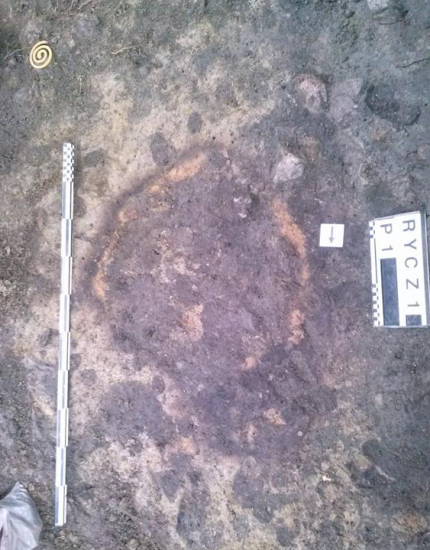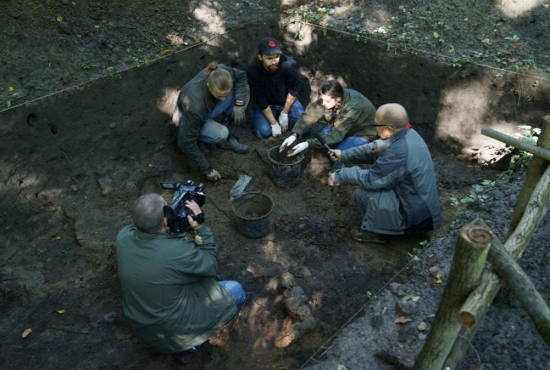PAP - Science and Scholarship in Poland
Source - http://www.naukawpolsce.pap.pl/en/news/news,400134,another-medieval-barrow-found-in-ryczyn.html

Hearth discovered on the barrow. Photo by Magdalena Przysiężna-Pizarska
In the ring fortress in Ryczyn (Lower Silesia), archaeologists discovered the remains of a thousand years old barrow. The discovery was accompanied by a large number (more than 50 thousand) of fragments of ceramic vessels.
Wrocław archaeologists have been studying the settlement complex in Ryczyn since 2004. In the case of barrows found during previous research seasons, they were able to determine their age by using dendrochronological method, involving the analysis of the grain of the wood, and based on objects found inside the barrows, at the first half of the 11th century.
"We do not know exactly when the barrow found during the last season was made. However, a thorough analysis indicates that it was erected already within the fortress, which points to a similar timeline as the other barrows. It was probably made during the so-called pagan reaction during the first phase of Christianisation" - explained Dr. Magdalena Przysiężna-Pizarska from the Department of Archaeology, University of Opole.
Archaeologists first stumbled upon a stone coat covering the barrow at the depth of 1.5 meters. Under the layer of stones they discovered a hearth located on the slope of the barrow. In addition to tens of thousands of fragments of pottery, they excavated many animal bones, charcoal and pugging residues. On the pugging, they noticed traces of organic elements: grass, leaves, branches and grain, which for archaeologists is an important source of information on vegetation in the area of Oława in the early Middle Ages.
"Below the hearth we located three mountain crystals. These were the rough crystal sticks. They certainly had magical significance. We know this, because such objects have been found in other locations associated with the cult" - argued Dr. Pizarska-Przysiężna.

Students from the Institute of History of the University of Opole with archaeological specialization performing archaeological exploration of the barrow layers during an interview for a local TV channel. Photo by Magdalena Przysiężna-Pizarska
During recent excavations, archaeologists also discovered the first residential building identified in the early medieval Ryczyn.
So far, the researchers have found three early medieval burial barrows, located on the north side of the castle. They contained cremation burials. The analysis revealed that among the remains there were both human and animal bones. Under cremated bones, archaeologists found numerous animal burials, interpreted as a sacrifice.
"The specific way in which the dismembered animal sacrifices were posed caught our attention. We noticed a layer system of animals. At the top were the largest animals: cow, horse, then smaller: sheep, goat, pig, and then a dog, then birds, and then fish. The last layer were egg shells and mussels" - said the archaeologist.
Under the complex system of animal bones, archaeologists discovered more burned human and animal bones surrounded by boards.
During the next season, scientists will try to answer the question, how big the town was in the 1130s. Last year's excavations took place in August and September.
According to the written sources, Ryczyn was one of the most important towns in the early Piast state in Silesia. Bishops had sought refuge there after the outbreak of the Slavonic rebellion in the 11th century. Prince Louis Brest was looking for their burials in Ryczyn in 1390. His work is considered to be the first excavations carried out in Poland.
Head of the mission in Ryczyn is Prof. Sławomir Moździoch of the Institute of Archaeology and Ethnology PAS. Head of field work is Dr. Magdalena Przysiężna-Pizarska. Students from the Institute of History of the University of Opole with archaeological specialization actively participate in the project.